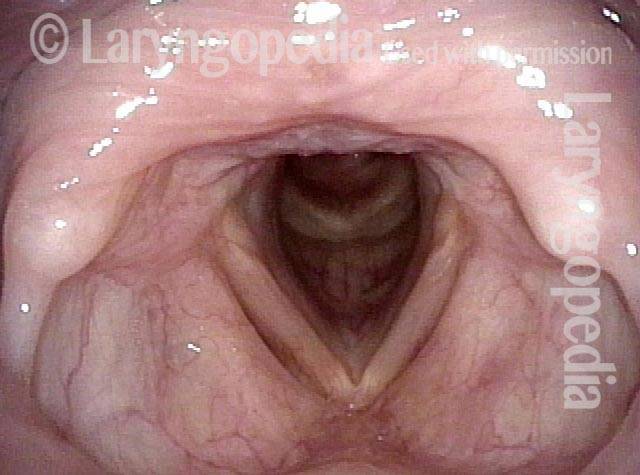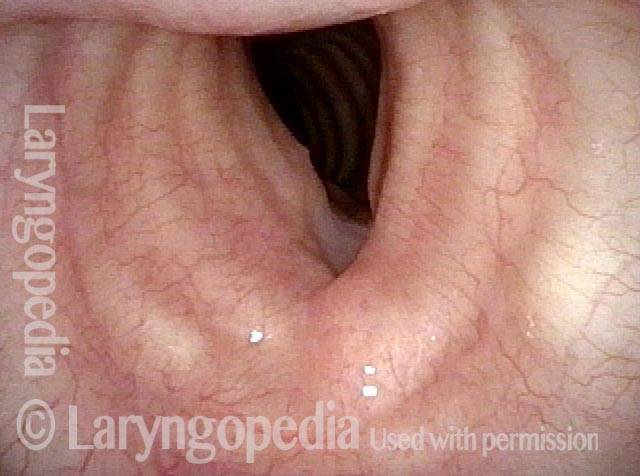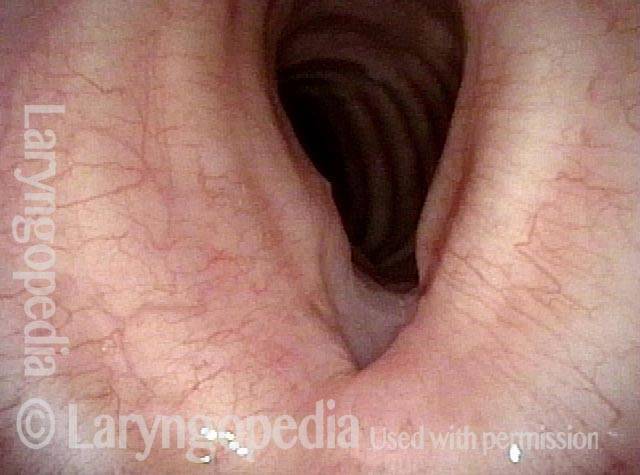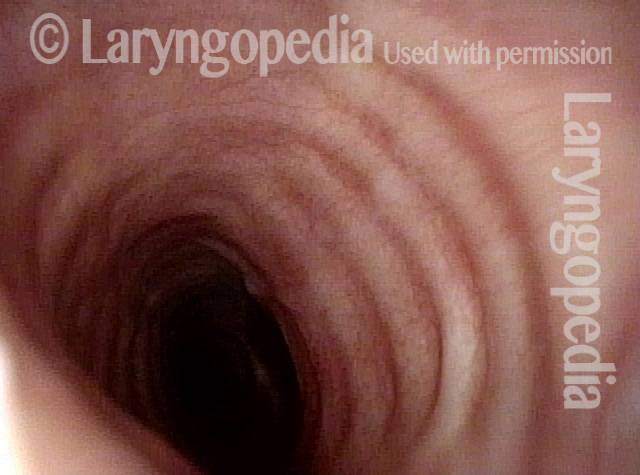Cricopharyngeal Spasm (CPS)
Hyper-contraction of the cricopharyngeus muscle, which causes a constricted or lump-in-the-throat sensation. Cricopharyngeal spasm (CPS) is a harmless disorder, but it can cause great anxiety for somebody who is experiencing it and has not received a clear diagnosis for the symptoms.
The Physiology of Cricopharyngeal Spasm
The cricopharyngeus muscle, or upper esophageal sphincter, is a ring of muscle that encircles the upper end of the esophagus. This muscle is constantly contracted, closing off the entrance to the esophagus, except when a person swallows, at which point the muscle relaxes momentarily to let the food or liquid pass through.
In a person with cricopharyngeal spasm, the problem is that the cricopharyngeus muscle is overly contracted when in its state of habitual contraction. This hyper-contraction or hyper-tonic state may be felt by the person. However, the muscle will still relax properly during swallowing, and thus does not impede swallowing.
Symptoms of Cricopharyngeal Spasm
Individuals with cricopharyngeal spasm may describe a persistent sensation—usually felt precisely at the level of the cricoid cartilage—of something stuck in the throat, like a “wad of phlegm” or a “golf ball,” which the person cannot swallow or spit out. Or, similarly, they might say that they feel a sensation of choking or constriction in the throat. These kinds of symptoms may become worse as the day goes on, or in stressful situations.
However, a key indicator of cricopharyngeal spasm is that the person can still eat and drink without trouble, and that the troubling sensations described above actually tend to diminish or disappear when the person is eating. This happens because the cricopharyngeus muscle relaxes during swallowing (as it should), which temporarily relieves the hyper-contraction sensations. Very infrequent swallows of small amounts of saliva are not sufficient to be “therapy” for the hyper-contracted muscle, but swallowing one bite of food after another (as during a meal) is.
Treatment for Cricopharyngeal Spasm
For many patients with cricopharyngeal spasm, receiving a clear diagnosis is the start of the resolution of the problem. Once they understand the nature of their problem, and that it does not pose any risk to them, they can “throw their worry over the shoulder.” In many cases, the symptoms subsequently go away within a few weeks.
If the problem persists and continues to trouble the patient, a clinician might provide a few doses of valium, not as treatment, but so that each dose can serve as a diagnostic test to further prove the diagnosis to the patient, that it is a muscle-contraction issue. Also, if need be, some clinicians may try therapy such as neck relaxation exercises under the care of a speech pathologist or physical therapist.
Tracheal Stenosis Here Is A Red Herring; the Diagnosis Is Actually CPS
Tracheal stenosis? (1 of 4)
Tracheal stenosis? (1 of 4)
Narrowing at trachea (2 of 4)
Narrowing at trachea (2 of 4)
Closer view (3 of 4)
Closer view (3 of 4)
No significant change in breathing (4 of 4)
No significant change in breathing (4 of 4)

Cricopharyngeal Spasm: A Troubling Feeling of a Lump in the Throat
Cricopharyngeal spasm is caused by over-contraction of the upper esophageal sphincter, or cricopharyngeus muscle, and causes an annoying, preoccupying, even anxiety-provoking sensation of something stuck in the throat, like a “wad of phlegm.” A common description is “There is something in my throat that I can’t swallow or spit out.”
What are the key symptoms of CPS?
Classic CPS symptoms share several features:
- A precise location (at the level of the cricoid cartilage in the mid- to low neck)
- A kind of sensation that is “lump, or pressure, or lodgment” (and not “pain, or burning, etc.”)
- Tendency to vary with the usual pattern being worsening as the day wears on, and with stress/ fatigue
- Eating makes it feel better, if only transiently.
If these are your symptoms ask your doctor to verify.
How is CPS diagnosed?
CPS is diagnosed primarily by history:
- location of sensation;
- nature of sensation;
- variation of symptom level (especially worse as the day wears on)
- and relief during mealtimes.
All of this combined with a normal physical examination are sufficient for diagnosis.
At our practice, no x-rays are required unless the person is having actual trouble with eating or drinking, or if there is anything atypical in the symptom complex listed above.
What is the difference between CPS and Sensory Neuropathic Throat Clearing?
CPS is a constant sensation of something stuck in the throat that may cause repetitive throat clearing. SNTC is an instantaneous sensation of a tickle or dryness that triggers an immediate throat clear or cough.
CPS is from hypertonicity of muscle; SNTC is from damaged nerve endings.
Does CPS affect swallowing?
Cricopharyngeal spasm doesn’t cause swallowing difficulty except with saliva. Eating is “therapy” that makes it feel better. You might look at Swallowing Trouble 101 for an overview of the swallowing mechanism.
CPS vs Antegrade Cricopharygeus Dysfunction
CPS causes a sensation of a lump but swallowing is fine and actually makes the lump sensation go away briefly; A-CPD causes tendency for solid food and pills to lodge in the mid-neck level and require careful chewing, liquid chaser, and dietary modification (or surgery).
Do anti-depressants help?
Benzodiazepines are only for “diagnosis,” only rarely for occasion very brief treatment. Look at the Journal Entry I’ve created on this subject for a more complete discussion of how to manage it.



